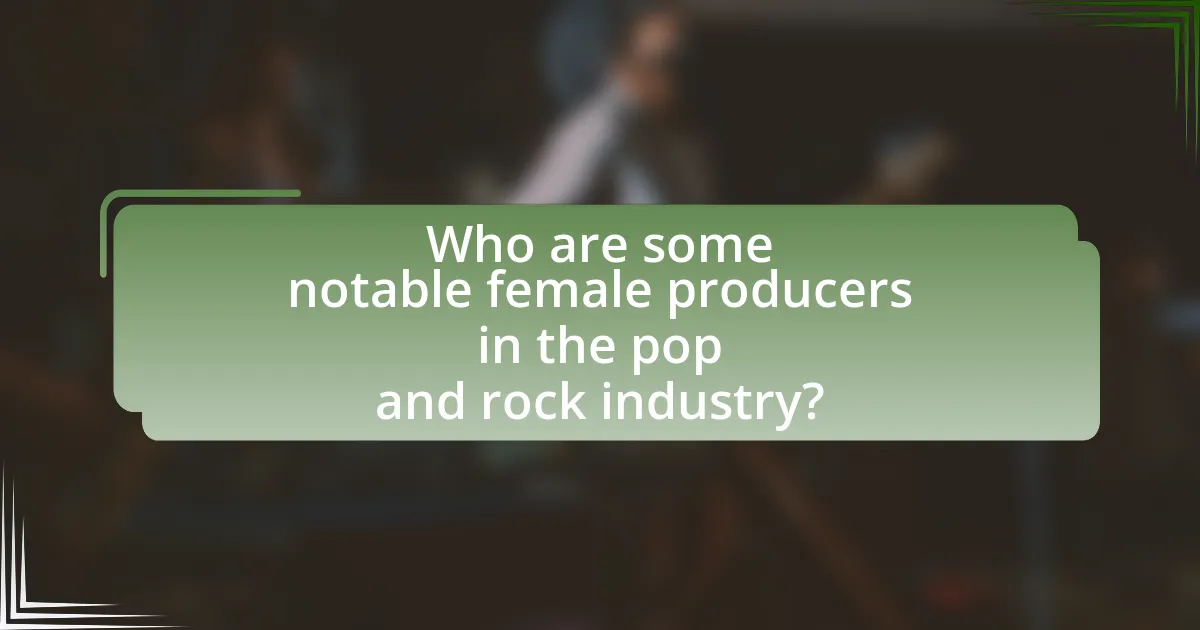The article examines the rise of female producers in the pop and rock industry, highlighting key factors such as increased visibility, changing industry dynamics, and advocacy for gender equality. It discusses how cultural shifts and social movements have empowered women in production roles, while also addressing the challenges they face, including systemic gender bias and limited access to networking opportunities. The impact of technology on female participation in production is explored, along with notable female producers and their contributions to the music landscape. The article concludes with insights on the future outlook for female producers and the importance of continued support and initiatives to promote gender equality in the industry.

What factors have contributed to the rise of female producers in the pop and rock industry?
The rise of female producers in the pop and rock industry has been driven by increased visibility, changing industry dynamics, and advocacy for gender equality. Increased visibility has come from successful female artists and producers, such as Linda Perry and Billie Eilish, who have demonstrated that women can excel in production roles. Changing industry dynamics include the democratization of music production technology, allowing more women to enter the field without traditional barriers. Advocacy for gender equality, highlighted by initiatives like the #MeToo movement and organizations such as Women in Music, has pushed for more inclusive practices within the industry. These factors collectively contribute to a more supportive environment for female producers, leading to their rise in prominence.
How has the cultural landscape shifted to support female producers?
The cultural landscape has shifted to support female producers through increased visibility, advocacy, and industry initiatives aimed at promoting gender equality. Organizations like Women in Music and initiatives such as the Recording Academy’s advocacy for female representation have created platforms that empower women in production roles. Additionally, data from the Annenberg Inclusion Initiative indicates that the percentage of female producers in popular music has risen, reflecting a growing recognition of their contributions and the dismantling of barriers that previously limited their opportunities. This shift is further evidenced by high-profile collaborations and mentorship programs that actively promote female talent in the industry.
What role do social movements play in empowering female producers?
Social movements play a crucial role in empowering female producers by advocating for gender equality and challenging systemic barriers within the music industry. These movements raise awareness about the underrepresentation of women in production roles, leading to initiatives that promote inclusivity and support for female talent. For instance, organizations like Women in Music and She Is the Music provide resources, mentorship, and networking opportunities specifically aimed at women in the industry. Research indicates that increased visibility and support from social movements have resulted in a measurable rise in the number of female producers, contributing to a more diverse and equitable music landscape.
How have changes in technology influenced female participation in production?
Changes in technology have significantly increased female participation in production within the pop and rock industry. The advent of digital audio workstations (DAWs) and affordable recording equipment has democratized music production, allowing women to create, record, and produce music from home studios. For instance, the rise of platforms like Pro Tools and Ableton Live has enabled female artists and producers to gain technical skills and control over their creative processes, leading to a notable increase in female representation in production roles. According to a 2021 report by the Annenberg Inclusion Initiative, women accounted for 21.6% of producers in popular music, a figure that has been gradually rising as technology continues to evolve and become more accessible.
What challenges have female producers faced in the industry?
Female producers have faced significant challenges in the industry, primarily due to systemic gender bias and underrepresentation. According to a 2021 report by the Annenberg Inclusion Initiative, women accounted for only 2.6% of producers across the top 600 songs from 2012 to 2020, highlighting the stark gender disparity. Additionally, female producers often encounter obstacles such as lack of access to networking opportunities, mentorship, and funding, which are more readily available to their male counterparts. These barriers contribute to a challenging environment where female talent struggles to gain recognition and advancement in a predominantly male-dominated field.
How do gender biases manifest in the music production field?
Gender biases in the music production field manifest through systemic barriers that limit opportunities for women, resulting in underrepresentation and unequal treatment. Research indicates that women account for only 2% of producers in the music industry, highlighting a significant gender disparity. Additionally, female producers often face skepticism regarding their technical abilities and creative decisions, which can lead to a lack of support and mentorship compared to their male counterparts. This bias is further reinforced by industry norms that prioritize male voices and perspectives, making it challenging for women to gain recognition and advancement in their careers.
What barriers exist for women entering production roles?
Barriers for women entering production roles include gender bias, lack of mentorship, and limited access to networking opportunities. Gender bias manifests in the perception that production is a male-dominated field, which can discourage women from pursuing these roles. A study by the Annenberg Inclusion Initiative found that only 2% of producers in popular music are women, highlighting the significant underrepresentation. Additionally, the absence of mentorship programs specifically aimed at women in production limits their professional development and guidance. Furthermore, women often face challenges in accessing industry networks that are crucial for career advancement, as these networks have historically been male-centric.

Who are some notable female producers in the pop and rock industry?
Notable female producers in the pop and rock industry include Linda Perry, who has produced hits for artists like Christina Aguilera and Pink, and Fiona Apple, known for her work on her own albums and collaborations. Additionally, Jack Antonoff, while primarily recognized as a male producer, has frequently collaborated with female artists, showcasing the importance of female influence in production. Other significant figures include Grimes, who produces her own music, and Natalie Maines of the Dixie Chicks, who has taken on production roles. These women have made substantial contributions to the industry, demonstrating their impact through successful projects and collaborations.
What impact have these producers had on the music they create?
Female producers have significantly transformed the music they create by introducing diverse perspectives and innovative techniques. Their influence has led to a broader range of sounds and themes in pop and rock music, often incorporating elements that reflect their unique experiences and cultural backgrounds. For instance, producers like Linda Perry and Imogen Heap have not only shaped the sonic quality of tracks but have also pushed for lyrical content that addresses social issues, personal narratives, and emotional depth. This shift has been evidenced by the increased representation of women in production roles, which has correlated with a rise in chart-topping hits that resonate with a wider audience, showcasing the importance of female voices in the industry.
How have their unique styles influenced the sound of pop and rock music?
Female producers have significantly influenced the sound of pop and rock music by introducing diverse perspectives and innovative techniques. Their unique styles often incorporate elements from various genres, leading to a richer and more eclectic sound. For instance, producers like Linda Perry and Imogen Heap have blended rock with electronic and pop elements, creating new sonic landscapes that challenge traditional genre boundaries. This has resulted in chart-topping hits that showcase a fusion of styles, such as Perry’s work with artists like Pink and Christina Aguilera, which has helped redefine mainstream pop. Additionally, the rise of female producers has encouraged greater representation and collaboration in the industry, fostering an environment where varied influences can thrive, ultimately shaping the evolution of pop and rock music.
What collaborations have been significant in showcasing their talents?
Significant collaborations that have showcased the talents of female producers in the pop and rock industry include the partnership between Taylor Swift and Jack Antonoff, which has resulted in critically acclaimed albums like “1989” and “Lover.” These collaborations highlight the creative input and production skills of female producers, as Antonoff has often credited Swift’s vision and direction in their work together. Another notable collaboration is between Billie Eilish and her brother Finneas O’Connell, where Finneas, as a producer, has played a crucial role in shaping Eilish’s sound, leading to multiple Grammy Awards and widespread recognition. These examples illustrate how collaborations not only elevate the profiles of female producers but also contribute to the overall success of the projects they work on.
How do these producers navigate the industry landscape?
Female producers navigate the industry landscape by leveraging their unique perspectives and experiences to create innovative music while building strong networks and advocating for representation. They often collaborate with other artists and producers, which enhances their visibility and influence within the industry. For instance, statistics show that female producers have increased their presence in top-charting songs, demonstrating their impact on mainstream music. Additionally, organizations like Women in Music provide resources and support, helping female producers to overcome barriers and establish successful careers.
What strategies do successful female producers employ to establish their careers?
Successful female producers establish their careers by leveraging networking, mentorship, and showcasing their unique perspectives in music production. Networking allows them to build relationships within the industry, leading to collaborative opportunities and increased visibility. Mentorship from established figures provides guidance and support, helping them navigate challenges and gain credibility. Additionally, by incorporating their distinct experiences and viewpoints into their work, they create innovative sounds that resonate with diverse audiences, thereby enhancing their marketability. These strategies have been instrumental in the rise of female producers, as evidenced by the increasing number of women recognized in major music awards and industry roles.
How do mentorship and networking play a role in their success?
Mentorship and networking are crucial for the success of female producers in the pop and rock industry as they provide guidance, support, and opportunities for collaboration. Female producers often benefit from mentorship by gaining insights from experienced professionals, which helps them navigate industry challenges and develop their skills. Networking allows them to build relationships with other industry players, leading to collaborations that can enhance their visibility and career prospects. Research indicates that women in music who engage in networking are more likely to secure opportunities and advance in their careers, as highlighted in the 2020 report by the Annenberg Inclusion Initiative, which found that women in music production often rely on connections to access resources and platforms that promote their work.

What is the future outlook for female producers in the pop and rock industry?
The future outlook for female producers in the pop and rock industry is increasingly positive, driven by a growing recognition of their contributions and a shift towards inclusivity. Recent statistics indicate that the percentage of women working as producers has risen, with reports showing that female producers accounted for 21% of all producers in 2021, up from 12% in 2019, according to the Annenberg Inclusion Initiative. This trend is supported by initiatives aimed at promoting gender diversity in music production, such as the She Is The Music organization, which focuses on increasing the number of women in music roles. As more female producers gain visibility and influence, the industry is likely to see a broader range of perspectives and sounds, further enhancing the creative landscape of pop and rock music.
How can the industry continue to support female talent?
The industry can continue to support female talent by implementing mentorship programs that connect emerging female producers with established professionals. Research indicates that mentorship significantly enhances career advancement opportunities; for instance, a study by the American Association of University Women found that women with mentors are more likely to achieve leadership roles. Additionally, the industry should prioritize equitable hiring practices and create platforms that showcase female talent, as evidenced by initiatives like the Women in Music organization, which advocates for gender equality in the music industry. These actions not only foster an inclusive environment but also contribute to a diverse creative landscape, ultimately benefiting the industry as a whole.
What initiatives are being implemented to promote gender equality in music production?
Initiatives promoting gender equality in music production include mentorship programs, funding opportunities, and industry partnerships aimed at increasing female representation. Organizations like Women in Music and the Recording Academy’s Advocacy Committee have launched initiatives to provide resources and support for women in the industry. For example, Women in Music offers mentorship programs that connect emerging female producers with established professionals, facilitating knowledge transfer and networking. Additionally, the 2021 report by the Annenberg Inclusion Initiative highlighted that only 2% of producers in popular music are women, underscoring the need for these initiatives to address the gender disparity effectively.
How can emerging female producers find opportunities in a competitive market?
Emerging female producers can find opportunities in a competitive market by leveraging networking, mentorship, and collaboration. Building connections with industry professionals through events, social media, and organizations focused on women in music can open doors to projects and partnerships. Research indicates that women who engage in mentorship programs are more likely to advance in their careers, as highlighted in the 2021 report by the Women’s Audio Mission, which found that mentorship significantly boosts career progression for female audio professionals. Additionally, collaborating with other artists and producers can enhance visibility and create unique soundscapes that attract attention in a saturated market.
What practical steps can aspiring female producers take to succeed?
Aspiring female producers can succeed by actively seeking mentorship and networking opportunities within the industry. Building relationships with established producers and industry professionals can provide valuable insights and guidance. According to a study by the USC Annenberg Inclusion Initiative, women represent only 2% of producers in popular music, highlighting the need for increased visibility and support for female talent. Additionally, gaining technical skills through formal education or hands-on experience in music production software and equipment is crucial. Engaging in collaborative projects with other artists can also enhance visibility and showcase their unique sound. By participating in workshops and industry events, female producers can further expand their network and increase their chances of success.
What skills should they focus on developing for a successful career?
Female producers in the pop and rock industry should focus on developing technical skills, creative collaboration, and business acumen for a successful career. Technical skills include proficiency in music production software and audio engineering, which are essential for creating high-quality recordings. Creative collaboration involves effective communication and teamwork with artists and other industry professionals, fostering an environment where innovative ideas can flourish. Business acumen encompasses understanding the music industry landscape, including contracts, marketing, and financial management, which are crucial for navigating a successful career. These skills are supported by industry trends showing that women who possess a blend of technical expertise and strong interpersonal skills are increasingly recognized and valued in the music production field.
How can they leverage technology and social media to enhance their visibility?
Female producers in the pop and rock industry can leverage technology and social media to enhance their visibility by utilizing platforms like Instagram, TikTok, and YouTube to showcase their work and connect with audiences. These platforms allow them to share behind-the-scenes content, music production processes, and personal stories, which can humanize their brand and attract followers. For instance, TikTok’s algorithm promotes creative content, enabling producers to reach wider audiences quickly; in 2021, TikTok reported that 67% of users felt more connected to brands that engage with them on the platform. Additionally, using analytics tools available on these platforms can help female producers understand their audience better and tailor their content accordingly, further increasing engagement and visibility.




